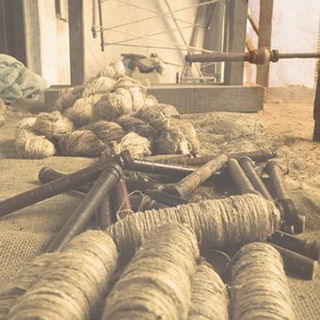

CHAPTER I . WOVEN TEXTILES
Khadi

“This is sacred cloth.”
Mahatma Gandhi
KHADI: MUCH MORE THAN A FABRIC
Khadi is any cloth that is hand spun and hand woven. A 5,000-year-old craft that Mahatma Ghandi rekindled in India about 100 years ago. In 1918, Mahatma Gandhi started his movement for Khadi when spinning and weaving were elevated to an ideology for self-reliance and self-governance.
Khadi became not only a symbol of revolution and resistance, but also the face of an Indian identity! It marked the start of a democracy in the true sense.
Mahatma Gandhi, who always wore Khadi, called it the “fabric of Indian independence.” He championed and supported the resurgence of Khadi to relieve poverty in villages across the country.
Khadi is much more than a fabric. It is a thought, an idea to unite a community and create a sustainable economic opportunity for everyone within the community. Khadi means jobs for everyone: it is the fabric of the revolution.
Irregularities are always to be found throughout a length of Khadi. Defects derived from human hands - this is the beauty of Khadi! It is this handmade quality of the cloth, with its inherent story of human energy.
Khadi is not just a sound economic proposition.
It is culture and tradition; it is the Khadi Spirit.
A WAY OF LIFE
Khadi is a decentralised labour-intensive tool-based local cloth production, and encourages local consumption. It brings power to the grass roots from the top, it places non-violence in front of force, constructive work instead of class conflict, democracy instead of controls, aiming at the sanctity of means instead of final objectives and a philosophy about the individual instead of a collectivist philosophy, it is not just merely a piece of cloth but a way of life.
LESS MATERIALS & ENERGY
The tools used in Khadi like the spinning wheel and hand-looms, are extremely simple and inexpensive. These instruments are constructed from renewable resources, like wood or bamboo, within a few hours by any carpenter, and are easily available to all including the weakest in the society. The resources consumed are very minimal compared to large textile industries.
The energy source for Khadi is human power. Since it uses as little as possible in the way of material and energy, it certainly fulfills the second criteria to call it a green economy craft.
THE FUTURE OF KHADI
Khadi has re-emerged as the fabric of the people, highly regarded for its durability, soft-feel and versatility. Fashion designers and consumers alike are drawn to its story, artisanal roots, sustainability and low carbon footprint.
In a world where slow fashion is regaining favour, Khadi is set to revive the artisanal traditions, skills and history, bringing vitality and sustainability back into rural Indian village communities.
4 REASONS TO USE KHADI
KHADI
Shop
A Khadi enterprise does not produce just a piece of cloth; it creates self-sustained growth. It promotes a non-violent social order and operates as Gandhi emphasised: “The goal of constructive work is not to provide economic relief to the unemployed or to distribute some wages to the poor but to build a strong non-violent social order”. Moreover, it creates so much interdependence within the community that it enables one to understand the value of interdependence almost at every step unlike the present system, which alienates people from one another.
EMPLOYMENT
COMMUNITY'S VITALITY
With Khadi, an entire community with different intelligent capacities as well as the physically challenged can involve themselves since it is simple and easy to learn and pursue. There is more space for freedom since each person of a community is self-reliant.
Khadi is such an occupation that the entire family can involve in production despite being from different age groups.
-
Employment . It provides employment to approximately 50.000 people,
most coming from the lower middle class of the society.
-
Comfort . It’s a unique cloth which is warm in winters and cool in summers.
Its the cloth Gandhi wore after he attached himself to Indian freedom movement.
-
Long Life . It has a long life even after hundreds of wash the texture, color,
and quality remains intact. The cloth is also economical.
-
Eco-Friendly . Gandhi always wanted Indians to have an eco-friendly lifestyle:
Khadi does not rely on electricity as it’s a simple process of hand-weaving.
"Using Khadi is the foundation of swadeshi, since Khadi is the only thing which can be made from thick yarn, and made easily. It has not so far had to compete with machine-made cloth. The consumption of Khadi alone enables lakhs of poor people to earn an honest living, staying at home."
Mahatma Gandhi
GOOD TO KNOW
Mano Etna products

100%
handmade
sustainable materials
preferred


























